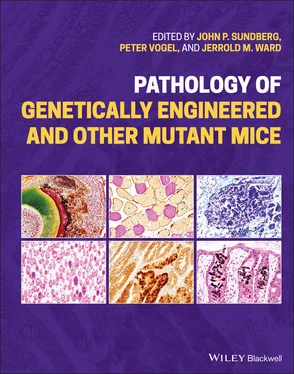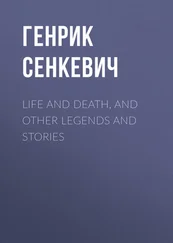Pathology of Genetically Engineered and Other Mutant Mice
Здесь есть возможность читать онлайн «Pathology of Genetically Engineered and Other Mutant Mice» — ознакомительный отрывок электронной книги совершенно бесплатно, а после прочтения отрывка купить полную версию. В некоторых случаях можно слушать аудио, скачать через торрент в формате fb2 и присутствует краткое содержание. Жанр: unrecognised, на английском языке. Описание произведения, (предисловие) а так же отзывы посетителей доступны на портале библиотеки ЛибКат.
- Название:Pathology of Genetically Engineered and Other Mutant Mice
- Автор:
- Жанр:
- Год:неизвестен
- ISBN:нет данных
- Рейтинг книги:3 / 5. Голосов: 1
-
Избранное:Добавить в избранное
- Отзывы:
-
Ваша оценка:
- 60
- 1
- 2
- 3
- 4
- 5
Pathology of Genetically Engineered and Other Mutant Mice: краткое содержание, описание и аннотация
Предлагаем к чтению аннотацию, описание, краткое содержание или предисловие (зависит от того, что написал сам автор книги «Pathology of Genetically Engineered and Other Mutant Mice»). Если вы не нашли необходимую информацию о книге — напишите в комментариях, мы постараемся отыскать её.
An updated and comprehensive reference to pathology in every organ system in genetically modified mice Pathology of Genetically Engineered and Other Mutant Mice
Pathology of Genetically Engineered and Other Mutant Mice
Pathology of Genetically Engineered and Other Mutant Mice — читать онлайн ознакомительный отрывок
Ниже представлен текст книги, разбитый по страницам. Система сохранения места последней прочитанной страницы, позволяет с удобством читать онлайн бесплатно книгу «Pathology of Genetically Engineered and Other Mutant Mice», без необходимости каждый раз заново искать на чём Вы остановились. Поставьте закладку, и сможете в любой момент перейти на страницу, на которой закончили чтение.
Интервал:
Закладка:
5 5 Schofield, P.N., Ward, J.M., and Sundberg, J.P. (2016). Show and tell: disclosure and data sharing in experimental pathology. Dis. Models Mech. 9 (6): 601–605.
6 6 Sundberg, J.P., Silva, K.A., Li, R. et al. (2004). Adult‐onset alopecia areata is a complex polygenic trait in the C3H/HeJ mouse model. J. Invest. Dermatol. 123 (2): 294–297.
7 7 Sundberg, J.P., Berndt, A., Sundberg, B.A. et al. (2016). Approaches to investigating complex genetic traits in a large‐scale inbred mouse aging study. Vet. Pathol. 53 (2): 456–467.
8 8 Treuting, P.M., Snyder, J.M., Ikeno, Y. et al. (2016). The vital role of pathology in improving reproducibility and translational relevance of aging studies in rodents. Vet. Pathol. 53 (2): 244–249.
9 9 Barthold, S.W., Borowsky, A.D., Brayton, C. et al. (2007). From whence will they come? – a perspective on the acute shortage of pathologists in biomedical research. J. Vet. Diagn. Invest. 19 (4): 455–456.
10 10 Nussbaum, R.L., McInnes, R.R., and Willard, H.F. (2007). Thompson & Thompson Genetics in Medicine, 7e. Philadelphia, PA: Saunders/Elsevier.
11 11 Dunn, T.B. (1949). Some observations on the normal and pathologic anatomy of the kidney of the mouse. J. Natl. Cancer Inst. 9 (4): 285–301.
12 12 Dunn, T.B. (1958). Morphology and pathology of reticular neoplasms in the mouse: relationship to man. Ann. N. Y. Acad. Sci. 76 (3): 619–628.
13 13 Grady, H.G. and Stewart, H.L. (1940). Histogenesis of induced pulmonary tumors in strain A mice. Am. J. Pathol. 16 (4): 417–432.5.
14 14 Cardiff, R.D., Anver, M.R., Boivin, G.P. et al. (2006). Precancer in mice: animal models used to understand, prevent, and treat human precancers. Toxicol. Pathol. 34 (6): 699–707.
15 15 Elmore, S.A., Cardiff, R., Cesta, M.F. et al. (2018). A review of current standards and the evolution of histopathology nomenclature for laboratory animals. ILAR J. 59 (1): 29–39.
16 16 Cardiff, R.D. and Borowsky, A.D. (2010). Precancer: sequentially acquired or predetermined? Toxicol. Pathol. 38 (1): 171–179.
17 17 Barthold, S.W., Griffey, S.M., and Percy, D.H. (2016). Pathology of Laboratory Rodents and Rabbits, 4e. Ames, IA: Wiley‐Blackwell.
18 18 Cheville, N.F. (2009). Ultrastructural Pathology. Ames, IA: Wiley‐Blackwell.
19 19 Fox, J.G., Barthold, S.W., Davisson, M.T. et al. (eds.) (2006). The Mouse in Biomedical Research: History, Wild Mice, and Genetics, 2e. Burlington, MA: Academic Press.
20 20 Haines, D.C., Chattopadhyay, S., and Ward, J.M. (2001). Pathology of aging B6; 129 mice. Toxicol. Pathol. 29 (6): 653–661.
21 21 Hedrich, H.J. (ed.) (2012). The Laboratory Mouse, 2e. Amsterdam: Academic Press.
22 22 Jones, T.C., Ward, J.M., Mohr, U., and Hunt, R.D. (eds.) (1990). Monographs on Pathology of Laboratory Animals: Hematopoietic System. Berlin: Springer‐Verlag.
23 23 Maronpot, R.R. (ed.) (1999). Pathology of the Mouse. Vienna, IL: Cache River Press.
24 24 Mohr, U. (ed.) (2001). International Classification of Rodent Tumors: The Mouse. Berlin: Springer.
25 25 Mohr, U., Dungworth, D.L., Capen, C.C. et al. (eds.) (1996). Pathology of the Aging Mouse., Vols. 1 and 2. Washington DC: ILSI Press.
26 26 Ruberte, J., Carretero, A., and Navarro, M. (eds.) (2017). Morphological Mouse Phenotyping: Anatomy, Histology and Imaging. Amsterdam: Academic.
27 27 Scudamore, C.L. (ed.) (2014). A Practical Guide to the Histology of the Mouse. Oxford: Wiley‐Blackwell.
28 28 Sundberg, J.P. and Boggess, D. (2000). Systematic Approach to Evaluation of Mouse Mutations. Boca Raton, FL: CDC Press.
29 29 Sundberg, J.P. and Ichiki, T. (eds.). Genetically Engineered Mice Handbook. Boca Raton,FL: CRC Press.
30 30 Frith, C.H. and Ward, J.M. (1988). Color Atlas of Neoplastic and Non‐neoplastic Lesions in Aging Mice. Amsterdam: Elsevier.
31 31 Turner, P.V., Brash, M.L., and Smith, D.A. (2017). Pathology of Small Animal Pets. Wiley‐Blackwell.
32 32 Wallig, M.A., Haschek, W.M., Rousseaux, C.G. et al. (eds.) (2018). Fundamentals of Toxicologic Pathology, 3e. London: Academic Press.
33 33 Smith, R.S., John, S.W.M., Nishina, P.M., and Sundberg, J.P. (eds.) (2002). Systematic Evaluation of the Mouse Eye. Boca Raton, FL: CRC Press.
34 34 Sundberg, J.P., Elson, C.O., Bedigian, H., and Birkenmeier, E.H. (1994). Spontaneous, heritable colitis in a new substrain of C3H/HeJ mice. Gastroenterology 107 (6): 1726–1735.
35 35 Ward, J.M., Mahler, J.F., Maronpot, R.R., and Sundberg, J.P. (eds.) (2000). Pathology of Genetically Engineered Mice. Ames, IA: Iowa State University Press.
36 36 Ward, J.M. and Treuting, P.M. (2014). Rodent intestinal epithelial carcinogenesis: pathology and preclinical models. Toxicol. Pathol. 42 (1): 148–161.
37 37 Radaelli, E., Castiglioni, V., Recordati, C. et al. (2016). The pathology of aging 129S6/SvEvTac mice. Vet. Pathol. 53 (2): 477–492.
38 38 Harbison, C.E., Lipman, R.D., and Bronson, R.T. (2016). Strain‐ and diet‐related lesion variability in aging DBA/2, C57BL/6, and DBA/2xC57BL/6 F1 mice. Vet. Pathol. 53 (2): 468–476.
39 39 Mikaelian, I., Nanney, L.B., Parman, K.S. et al. (2004). Antibodies that label paraffin‐embedded mouse tissues: a collaborative endeavor. Toxicol. Pathol. 32 (2): 181–191.
40 40 Janardhan, K.S., Jensen, H., Clayton, N.P., and Herbert, R.A. (2018). Immunohistochemistry in investigative and toxicologic pathology. Toxicol. Pathol. 46 (5): 488–510.
41 41 Ward, J.M. and Rehg, J.E. (2014). Rodent immunohistochemistry: pitfalls and troubleshooting. Vet. Pathol. 51 (1): 88–101.
42 42 Rehg, J.E. and Ward, J.M. (2017). Application of immunohistochemistry in toxicologic pathology of the hematopoietic system. In: Immunopathology in Toxicology and Drug Development (ed. G.A. Parker), 489–561. Springer.
43 43 Meyerholz, D.K. and Beck, A.P. (2018). Fundamental concepts for semiquantitative tissue scoring in translational research. ILAR J. 59 (1): 13–17.
44 44 Bleich, A., Mahler, M., Most, C. et al. (2004). Refined histopathologic scoring system improves power to detect colitis QTL in mice. Mamm. Genome 15 (11): 865–871.
45 45 Jurisic, G., Sundberg, J.P., Bleich, A. et al. (2010). Quantitative lymphatic vessel trait analysis suggests Vcam1 as candidate modifier gene of inflammatory bowel disease. Genes Immun. 11 (3): 219–231.
46 46 Turner, O.C., Aeffner, F., Bangari, D.S. et al. (2020). Society of toxicologic pathology digital pathology and image analysis special interest group article*: opinion on the application of artificial intelligence and machine learning to digital toxicologic pathology. Toxicol. Pathol. 48 (2): 277–294.
47 47 Aeffner, F., Zarella, M.D., Buchbinder, N. et al. (2019). Introduction to digital image analysis in whole‐slide imaging: a white paper from the digital pathology association. J. Pathol. Inform. 10: 9.
48 48 Ward, J.M., Schofield, P.N., and Sundberg, J.P. (2017). Reproducibility of histopathological findings in experimental pathology of the mouse: a sorry tail. Lab. Anim. (NY). 46 (4): 146–151.
49 49 Wolf, J.C. and Maack, G. (2017). Evaluating the credibility of histopathology data in environmental endocrine toxicity studies. Environ. Toxicol. Chem. 36 (3): 601–611.
50 50 Ince, T.A., Ward, J.M., Valli, V.E. et al. (2008). Do‐it‐yourself (DIY) pathology. Nat. Biotechnol. 26 (9): 978–979.
2 The Mouse Online: Open Mouse Biology and Pathology Data Resources for Biomedical Research:
Dale A. Begley, Paul N. Schofield, and John P. Sundberg
Introduction
Large collections of data and resources are available online, ranging from genomic and gene expression databases (GXDs) to archives of experimental data, phenotype data, and bioresources such as strains, cell lines, and tissues. While many core resources contain multispecies data and are good sources for mouse information, this review will cover some of the major websites that provide access to mouse‐centric databases ( Table 2.1) and how they can be used to assist with analysis of normal, abnormal, or mutant mice.
Читать дальшеИнтервал:
Закладка:
Похожие книги на «Pathology of Genetically Engineered and Other Mutant Mice»
Представляем Вашему вниманию похожие книги на «Pathology of Genetically Engineered and Other Mutant Mice» списком для выбора. Мы отобрали схожую по названию и смыслу литературу в надежде предоставить читателям больше вариантов отыскать новые, интересные, ещё непрочитанные произведения.
Обсуждение, отзывы о книге «Pathology of Genetically Engineered and Other Mutant Mice» и просто собственные мнения читателей. Оставьте ваши комментарии, напишите, что Вы думаете о произведении, его смысле или главных героях. Укажите что конкретно понравилось, а что нет, и почему Вы так считаете.












